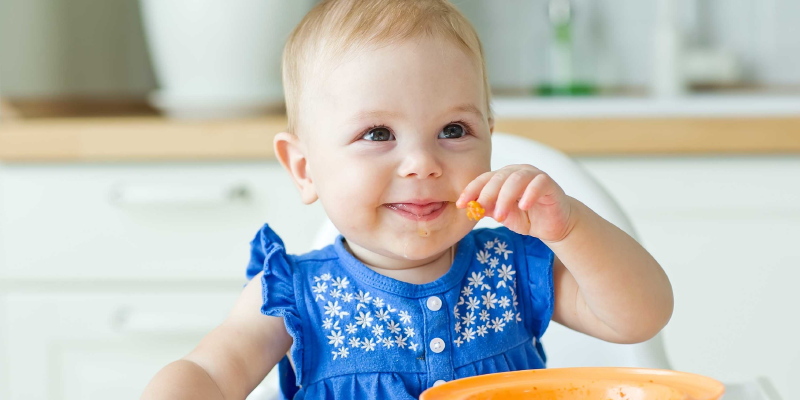You’ve seen it play out over and over: mom and dad hand-feeding a heaping spoonful of puree into baby’s wide open mouth. Obligatory airplane noises to boot because of course. But with baby-led weaning, parents take a very hands-off approach and baby is in charge. Your baby sits with a spread of finger foods in front of him and attempts to grasp the tiny bites from the tray and put them in his mouth all by himself. It’s an approach that is becoming popular and has massive benefits for parents who want to free up time spent feeding their baby. But what exactly is baby-led weaning? Here’s what you need to know before you begin!
The Benefits to Baby-Led Weaning
Baby-led weaning is a method that was first popularized in the U.K. about eight years ago after the book Baby-Led Weaning by Gill Rapley and Tracey Murkett came out. It has been catching on in the United States ever since. And it’s easy to see why when you consider the benefits. It can help fine-tune motor development for starters. Babies get to improve their hand-eye coordination, chewing skills and dexterity. Plus, it can form the foundation of healthy eating habits by giving babies the room to explore taste, texture, aroma and colors of newfound foods.
And if that wasn’t already enough of a reason to consider baby-led weaning, one of the biggest advantages is that it teaches your baby how to stop eating when he’s full. If a baby is feeding himself independently, he can’t be made to eat more than he needs. With parents sometimes there’s a tendency to sneak in a couple more bites, but it can teach your baby a bad habit early if he thinks he should always eat more than he needs. Early research has shown that baby-led weaning can have a huge impact on a child’s food preferences and eating habits.
Getting Started with Baby-Led Weaning
If you’re ready to bypass buying little jars of food or spending time making your own, here’s how you can get started with baby-led weaning. The ideal time for trying baby-led weaning is when your baby can sit in a high chair unassisted, has good neck strength and able to move food to the back of his mouth. A good estimate is between 6 and 9 months of age, or when your child has decent chewing skills. You’ll want to continue breastfeeding or formula as this is your baby’s biggest source of nutrition until he’s close to one year. These are other things to consider:
- Your baby needs to be supervised with baby-led weaning so avoid multi-tasking now that you’re officially “hands free.” The best case scenario is to include him at the table during family meals. You can even consider giving him what you’re eating at the time.
- The first foods he should try need to be soft like ripe fruits, cooked egg yolks, flaky fish, cooked pasta, puffed cereal and mushy vegetables. When you prepare those foods, make sure they’re cut into shapes that are easy for grasping by little fingers. Also consider the nutrients your baby may or may not be getting when you decide on foods to have him try.
- Baby-led weaning is full-on discovery for your baby which means big messes to clean up. Don’t be surprised when he smashes, smears, drops or throws pieces of food around as he’s exploring. This is all normal.
What Not to Do for Baby-Led Weaning
Since baby-led weaning is in itself an exploratory method for you and your baby, how it looks will be different for everyone. It may not work for some babies, for example those with food allergies or developmental delays, and that’s ok. And it isn’t a method to rush either. You’ll need to plan for extra time during meals, and it could take several tries before your baby seems interested in anything but pureed food. Here are some other things you shouldn’t do with baby-led weaning:
- Choose your feeding times carefully. A tired or upset baby is likely not in the mood for an entirely new eating experience.
- Don’t introduce too many foods at once. Start slowly and introduce a new food every four or five days so you can pinpoint any food allergies. And pay attention to your baby’s signals. If he’s throwing food and not acting interested in trying it, he’s probably done for that particular feeding.
- Try to remain calm and unaffected during the feedings. Babies are surprisingly capable of managing finger foods, but gagging is a normal reflex to get rid of food that he isn’t ready for. If you act scared, he will too. Overall, eating should be treated as a routine task.
- Stay away from choking hazards like grapes, hot dogs, raisins, popcorn, raw veggies and sticky peanut butter. It’s also good to make sure you’re equipped for infant CPR just in case. Always stay with your baby when he’s eating and make sure he’s sitting up. Food temperatures should range from barely warm to cool. And child-approved utensils should be introduced long after he’s been successful with feeding himself.
In the end, baby-led weaning is a method to try if you think it works for your family’s goals. If you’re comfortable with spoon-feeding, maybe try alternating between pureed and finger foods until your baby becomes a more confident eater. There’s no right or wrong way as long as he’s getting the necessary nutrients. Let him lead and proceed accordingly.
Join the other 100,000+ new parents who love Bitsy Boxes.
